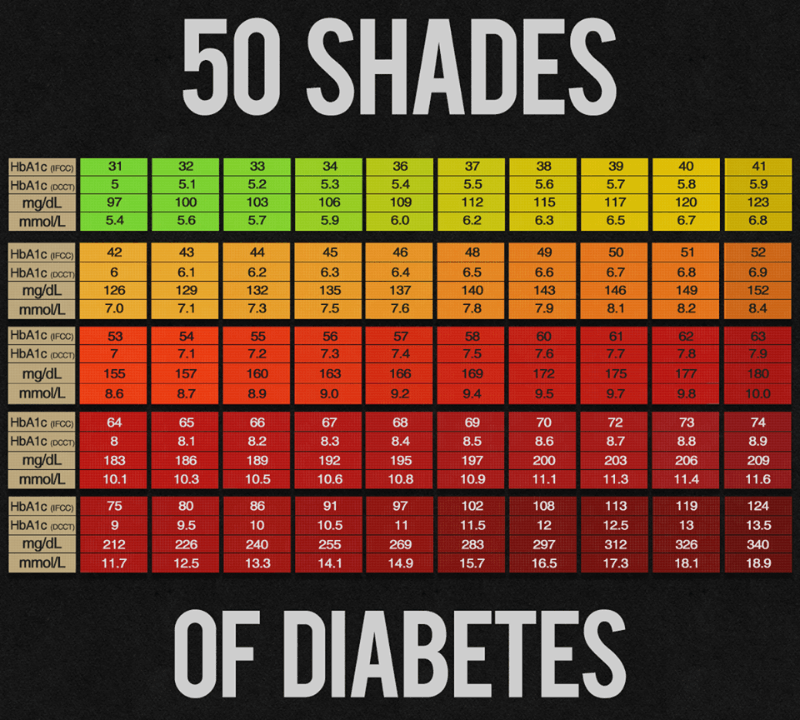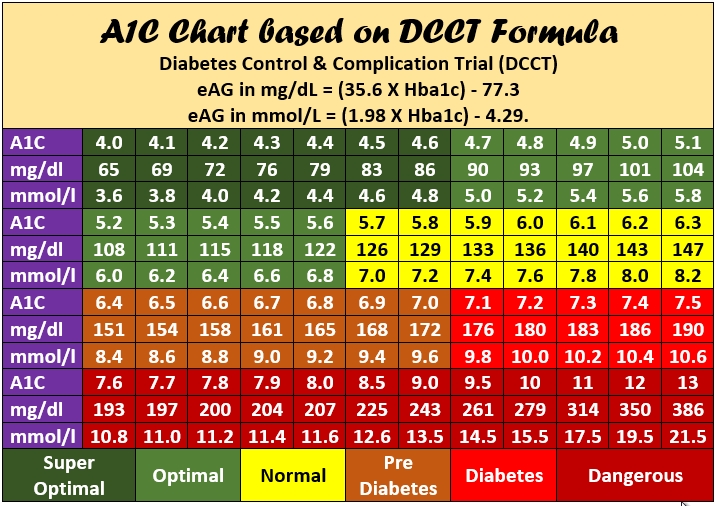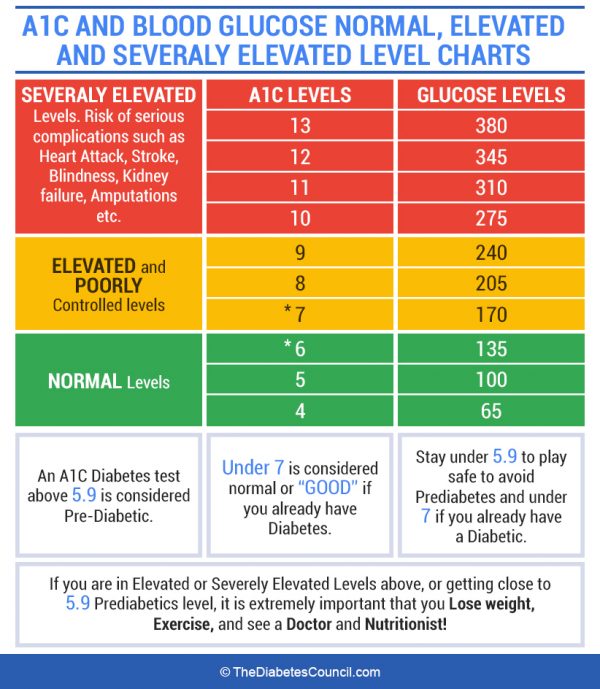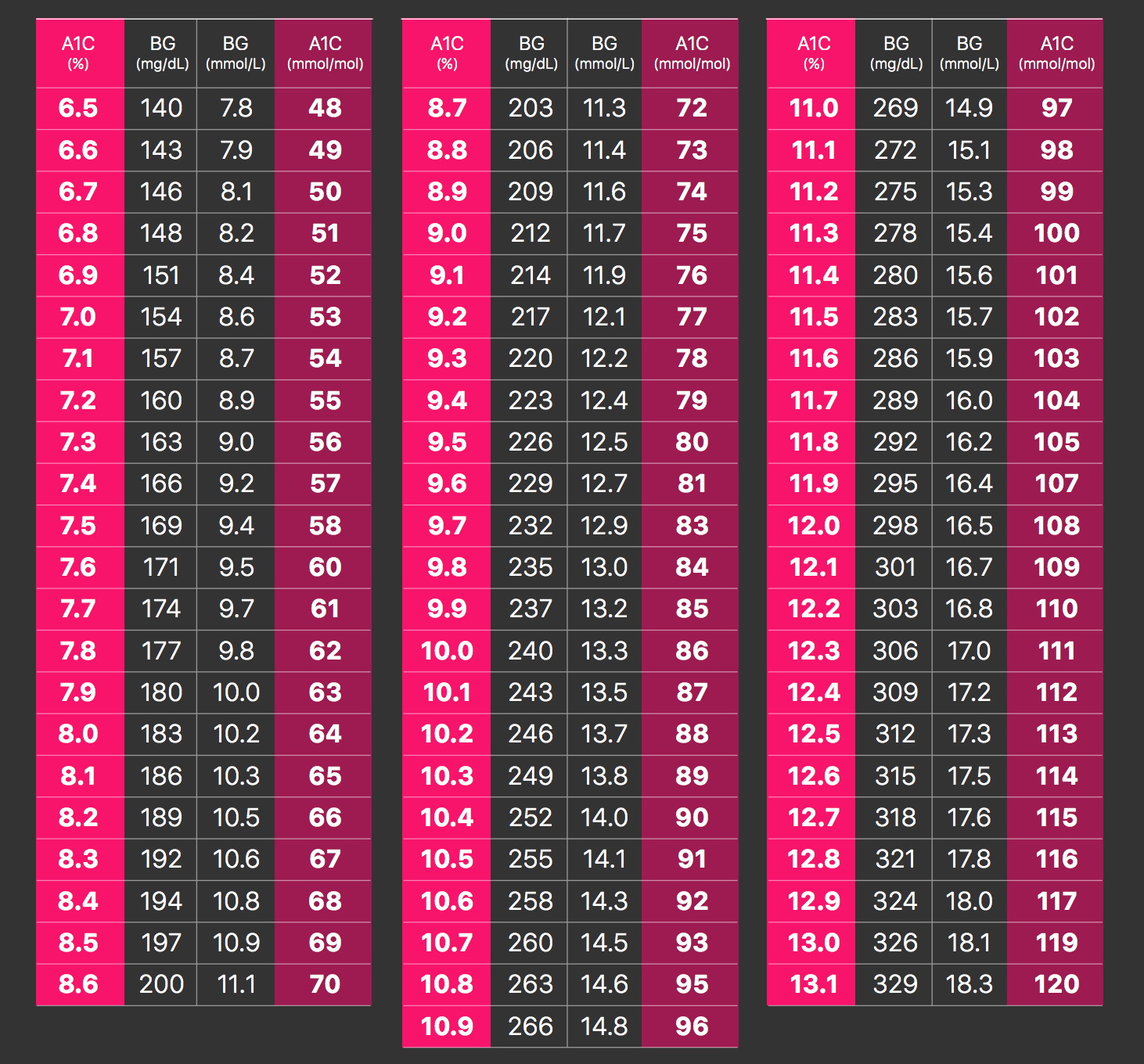An A1c chart is a useful tool for individuals with diabetes as it allows them to track their blood sugar levels over time. This chart provides valuable information that can help individuals manage their diabetes and make necessary adjustments to their treatment plans.
A1c Chart Printable
 One example of an A1c chart that is available for print is shown above. It provides a visual representation of blood sugar levels and their corresponding A1c values. This chart can be a helpful tool for individuals who want to monitor their A1c levels at home.
One example of an A1c chart that is available for print is shown above. It provides a visual representation of blood sugar levels and their corresponding A1c values. This chart can be a helpful tool for individuals who want to monitor their A1c levels at home.
A1c Levels and Blood Sugar Monitoring
 Tracking A1c levels is essential for individuals with diabetes as it gives them insight into their long-term blood sugar control. By monitoring their A1c levels, individuals can identify patterns and make adjustments to their diabetes management routine.
Tracking A1c levels is essential for individuals with diabetes as it gives them insight into their long-term blood sugar control. By monitoring their A1c levels, individuals can identify patterns and make adjustments to their diabetes management routine.
Autoimmune Protocol for Type 1 Diabetes
 For individuals with type 1 diabetes, following an autoimmune protocol may be a beneficial approach to managing their condition. This protocol focuses on reducing inflammation and supporting immune function. The A1c chart above may be used as a reference during this process.
For individuals with type 1 diabetes, following an autoimmune protocol may be a beneficial approach to managing their condition. This protocol focuses on reducing inflammation and supporting immune function. The A1c chart above may be used as a reference during this process.
Understanding HbA1c Blood Tests
 The HbA1c blood test is a common test used to monitor blood sugar levels in individuals with diabetes. This test provides an average blood sugar level over a three-month period. The chart above illustrates the normal range for HbA1c levels.
The HbA1c blood test is a common test used to monitor blood sugar levels in individuals with diabetes. This test provides an average blood sugar level over a three-month period. The chart above illustrates the normal range for HbA1c levels.
A1C to Blood Glucose Conversion
 It is important for individuals with diabetes to be able to convert their A1c levels into corresponding blood glucose values. The chart above provides a conversion table that can be used to determine blood glucose levels based on A1c values.
It is important for individuals with diabetes to be able to convert their A1c levels into corresponding blood glucose values. The chart above provides a conversion table that can be used to determine blood glucose levels based on A1c values.
Managing Type 1 Diabetes
 For individuals living with type 1 diabetes, consistent monitoring of A1c levels is crucial. By keeping their A1c levels within the target range, individuals can minimize the risk of long-term complications associated with diabetes.
For individuals living with type 1 diabetes, consistent monitoring of A1c levels is crucial. By keeping their A1c levels within the target range, individuals can minimize the risk of long-term complications associated with diabetes.
Interpreting A1c Levels
 The A1c levels chart shown above provides a breakdown of different A1c levels and their corresponding average blood sugar levels. This chart can help individuals understand the significance of their A1c test results and make informed decisions about their diabetes management.
The A1c levels chart shown above provides a breakdown of different A1c levels and their corresponding average blood sugar levels. This chart can help individuals understand the significance of their A1c test results and make informed decisions about their diabetes management.
A1C: What Do the Numbers Mean?
 Understanding the meaning behind A1c numbers is crucial for individuals with diabetes. The chart above provides an overview of the different A1c ranges and what they signify in terms of blood sugar control.
Understanding the meaning behind A1c numbers is crucial for individuals with diabetes. The chart above provides an overview of the different A1c ranges and what they signify in terms of blood sugar control.
The Importance of A1C Monitoring
 Regular A1c monitoring is crucial for individuals with diabetes as it provides an overall picture of their blood sugar control. By consistently tracking their A1c levels, individuals can identify trends, make necessary adjustments to their diabetes management, and reduce the risk of complications associated with diabetes.
Regular A1c monitoring is crucial for individuals with diabetes as it provides an overall picture of their blood sugar control. By consistently tracking their A1c levels, individuals can identify trends, make necessary adjustments to their diabetes management, and reduce the risk of complications associated with diabetes.
A1C Advice: Change What You Consider a High Blood Sugar
 One recommendation for individuals with diabetes is to re-evaluate what they consider to be a high blood sugar level. By striving for tighter blood sugar control and aiming to keep A1c levels within the target range, individuals can improve their overall health and well-being.
One recommendation for individuals with diabetes is to re-evaluate what they consider to be a high blood sugar level. By striving for tighter blood sugar control and aiming to keep A1c levels within the target range, individuals can improve their overall health and well-being.
In conclusion, an A1c chart is a valuable tool for individuals with diabetes as it allows them to track and monitor their blood sugar levels over time. By consistently monitoring their A1c levels and making necessary adjustments to their diabetes management routine, individuals can reduce the risk of complications associated with diabetes and improve their overall health.